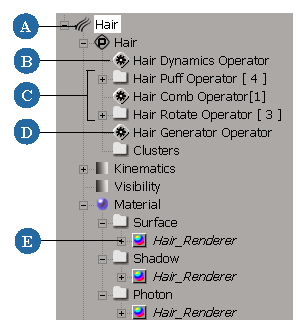Hair is actually an assembly of different parts that work together: the hair generator, the hair object (geometry), the emitter object, the dynamics engine, and the hair shader.
The hair emitter is the object from which the hair is emitted. This is any object that you select and apply hair to.
The hair generator is the operator that generates the hair strands.
The hair object is the actual object whose geometry is displayed as guide hairs. Styling operators you apply define the look of the guide hairs.
By default, the Hair Shading shader is a surface shader that is attached to hair to define the look of the render hairs. It lets you set the color on the hair strands, add transparency, self-shadowing, and optimize the rendering in different ways. You can also connect the Hair Gradient Material shader to hair, as well as other Softimage surface shaders.
If you apply dynamics to the hair, the dynamics operator is the engine that calculates the movement of the hair according to the velocity of the emitter object and any natural forces applied to the hair object.
In the explorer, you can see the relationship among all the parts that make up hair.

 Except where otherwise noted, this work is licensed under a Creative Commons Attribution-NonCommercial-ShareAlike 3.0 Unported License
Except where otherwise noted, this work is licensed under a Creative Commons Attribution-NonCommercial-ShareAlike 3.0 Unported License